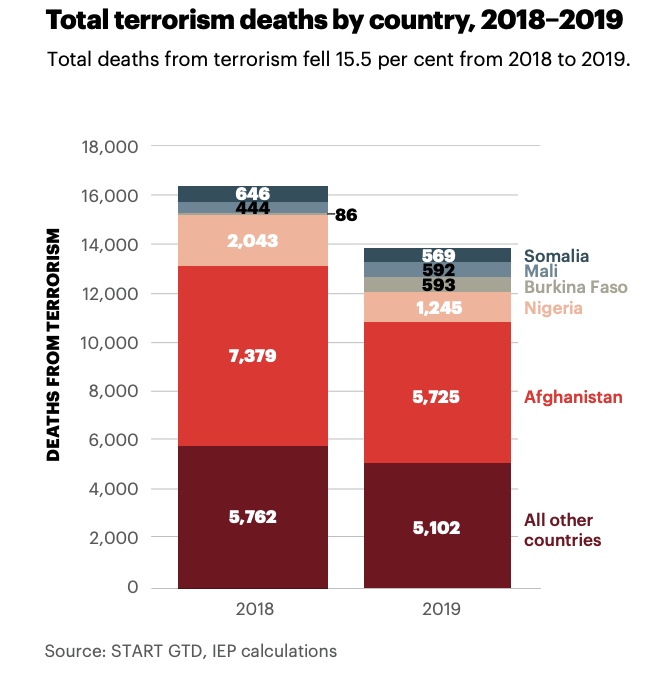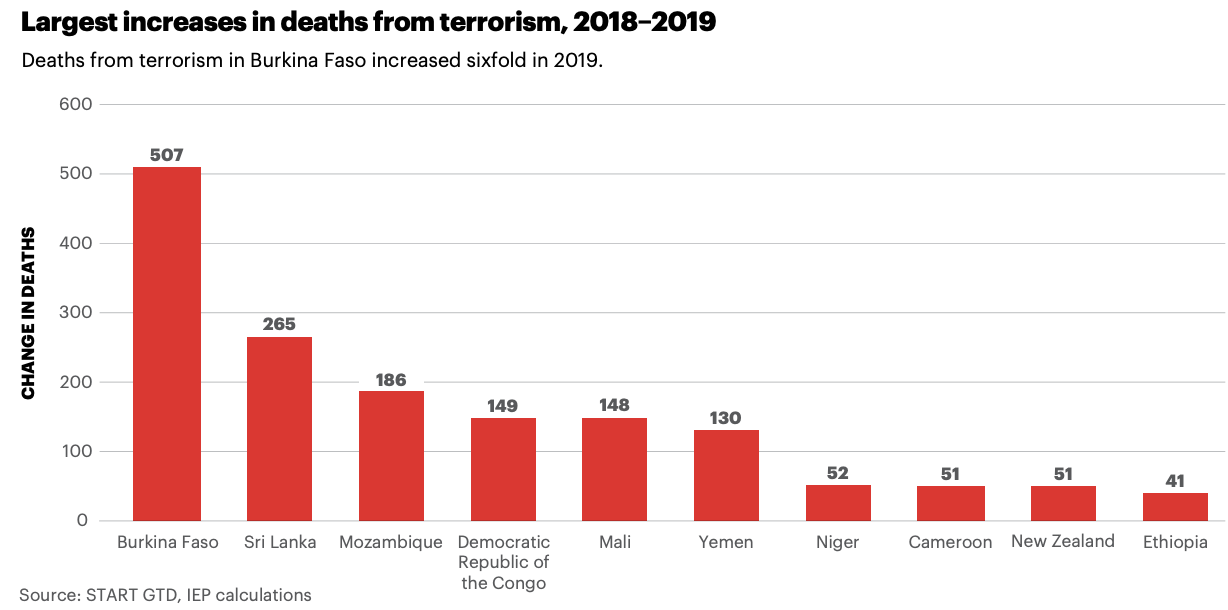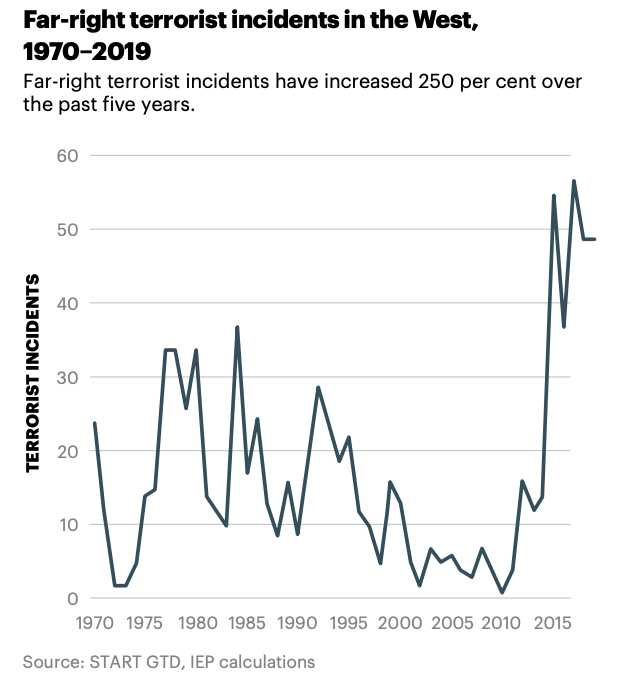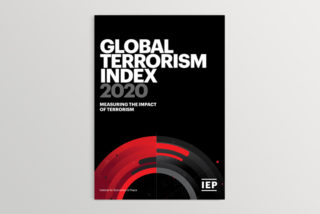This is the eighth edition of the Global Terrorism Index (GTI). The report provides a comprehensive summary of the key global trends and patterns in terrorism over the last 50 years, placing a special emphasis on trends over the past decade. This period corresponds with the rise and fall of the Islamic State of Iraq and the Levant (ISIL).
The GTI report is produced by the Institute for Economics & Peace (IEP) using data from the Global Terrorism Database (GTD) and other sources. Data for the GTD is collected and collated by the National Consortium for the Study of Terrorism and Responses to Terrorism (START) at the University of Maryland. The GTD contains over 170,000 terrorist incidents for the period 1970 to 2019.
In 2019, deaths from terrorism fell for the fifth consecutive year, after peaking in 2014. The total number of deaths fell by 15.5 per cent to 13,826. The fall in deaths was mirrored by a reduction in the impact of terrorism, with 103 countries recording an improvement on their GTI score, compared to 35 that recorded a deterioration. The full GTI score takes into account not only deaths, but also incidents, injuries, and property damage from terrorism, over a five-year period.
The largest fall in the impact of terrorism occurred in Afghanistan, which recorded 1,654 fewer deaths from terrorism in 2018, a 22.4 per cent decrease from the prior year. However, Afghanistan remains the country most impacted by terrorism, after overtaking Iraq in 2018.
Nigeria recorded the second largest reduction in deaths from terrorism in 2019, with the number falling from 2,043 to 1,245, a 39.1 per cent reduction, which was mainly due to a fall in terrorism deaths attributed to Fulani extremists. This reduction occurred despite a small increase in deaths attributed to Boko Haram, which has the been the most active terrorist group in the country over the past decade. Deaths from terrorism in Nigeria are now 83 per cent lower than at their peak in 2014.
Conflict remains the primary driver of terrorism, with over 96 per cent of deaths from terrorism in 2019 occurring in countries already in conflict. The ten countries with the highest impact of terrorism are all engaged in at least one armed conflict.

Despite the overall fall in the impact of terrorism across the world, it remains a significant and serious problem in many countries. There were 63 countries in 2019 that recorded at least one death from a terrorist attack and seventeen countries that recorded over 100 deaths from terrorism. However, only Afghanistan and Nigeria recorded over 1,000 deaths and both countries had significant reductions in the number of people killed in 2019. By contrast, in 2015 there were six countries that recorded over a thousand deaths from terrorism.
ISIL’s strength and influence continued to decline, with deaths attributed to the group in 2019 falling to 942, down from 1,571 in the previous year. This is the first time since the group became active in 2013, that it was responsible for less than a thousand deaths from terrorism in any one year. The number of terrorist attacks attributed to the group also fell to the lowest level since it was formed, with 339 incidents attributed to the group in 2019. However, despite the decrease in activity from ISIL in the Middle East and North Africa, ISIL’s affiliate groups remain active across the world, and have become especially prominent in sub-Saharan Africa where deaths attributed to ISIL affiliates increased. Twenty-seven countries experienced a terrorist attack caused by ISIL or one of its affiliates.
The expansion of ISIL affiliates into sub-Saharan Africa led to a surge in terrorism in many countries in the region. Seven of the ten countries with the largest increase in terrorism were in sub-Saharan Africa: Burkina Faso, Mozambique, Democratic Republic of Congo (DRC), Mali, Niger, Cameron and Ethiopia. These countries are also facing various ecological threats, are amongst the countries with the highest population growth and suffer from low societal resilience.
The largest increase in deaths from terrorism occurred in Burkina Faso, where deaths rose from 86 to 593, a 590 per cent increase. The rise was mainly driven by three groups: the Islamic State in Greater Sahara (ISGS), Jamaat Nusrat al-Islam wal Muslimin (JNIM) and the Burkina Faso branch of Ansar al- Islam.
Sri Lanka recorded the second largest increase in 2019, with the Easter Sunday bombings accounting for the entirety of this increase. Sri Lanka recorded the deadliest attack of 2019 when eight coordinated suicide attacks across the country targeted churches and hotels on Easter Sunday, killing 266 people and injuring at least 500. ISIL claimed responsibility for the attack, with the perpetrators pledging allegiance to former ISIL-leader Abu Bakr al-Baghdadi online.

South Asia remains the region most impacted by terrorism in 2019, despite the improvements in Afghanistan, Pakistan and India. This is the second year in a row that South Asia has recorded more deaths from terrorism than any other region.
ISIL’s shift to sub-Saharan Africa meant that the region recorded the second highest number of terrorism deaths, even after accounting for the substantial fall in Nigeria. Deaths attributed to ISIL affiliates in the region were recorded as far south as Mozambique and 41 per cent of all ISIL-related attacks in 2019 occurred in sub-Saharan Africa.
Terrorism comes with a heavy financial cost. The global economic impact of terrorism was US$26.4 billion in 2019, 25 per cent lower than in 2018. Whilst this figure is a small percentage of the total impact of violence on the global economy, it should be noted that the figures for terrorism are highly conservative as they do not account for many items, including the indirect impacts on business and investment, insurance costs, lost opportunity and the costs associated with security agencies in countering terrorism.
One of the more worrying trends in the last five years is the surge in far-right political terrorism, even though the absolute number of far-right attacks remains low when compared to other forms of terrorism. In North America, Western Europe, and Oceania, far-right attacks have increased by 250 per cent since 2014, with deaths increasing by 709 per cent over the same period. There were 89 deaths attributed to far-right terrorists in 2019, with 51 of those occurring in the Christchurch mosque attacks in New Zealand. There have been over 35 far-right terrorist incidents in the West every year for the past five years.
Far-right terrorism tends to be more lethal than far-left terrorism, but not as lethal as Islamist terrorism in the West. There have been 13 far-right terrorist attacks that have each killed more than ten people over the past 50 years, compared to 24 Islamist attacks, and three from other ideologies. Far-right terrorism is also more likely to be carried out by individuals unaffiliated with a specific terrorist group. Nearly 60 per cent of far-right attacks from 1970 to 2019 were carried out by unaffiliated individuals, compared to under ten per cent for both far-left and separatist terrorist groups.
There are some signs that political violence is becoming more publically acceptable, as the level of polarisation in society continues to rise. In the US, where the majority of far-right terrorism has taken place, nearly 40 per cent of both Democrat and Republican poll respondents in 2020 felt that violence for political ends was at least partially justifiable, up from less than ten per cent just two and half years earlier. Social and political instability has also been on the rise in the West, even prior to the widespread demonstrations seen in 2020. Nearly 70 violent demonstrations were recorded in the West in 2019, compared to 19 in 2011.
The rise in far-right terrorism comes at a time when Positive Peace is declining in many Western countries. The US had one of the largest deteriorations in Positive Peace, with its score deteriorating by 6.7 per cent over the past decade.
If the deterioration in Positive Peace in the West continues unchecked over the coming years, the background conditions are set for further social discontent, which may increase the likelihood for violence and terrorism.

The report also looks at the application of systems thinking to terrorism, using mainly statistical techniques and mathematical models to better understand the dynamics of terrorism and its subsequent impact on society. Terrorist groups flourish when they can increase their influence. The major drivers of influence are media coverage, recruitment of sympathisers, and finances. All of these different facets need to be tackled together to break up terrorist organisations.
There are many socio-economic factors that are associated with terrorism that are common to all countries. However, there are also notable differences between economically developed and developing countries. Some socio-economic factors associated with terrorism include:
As the threat of terrorism continues to change, policymakers need to be aware of novel approaches to counter-terrorism. The European Leadership Network is developing the concept of social impact bonds in relation to terrorism, with a particular focus on securing dangerous materials that could be used in sophisticated terrorist attacks, such as radioactive medical waste. There are already over 100 development or social impact bonds globally, but to date they have not been used for security purposes. An expert contribution in this edition of the GTI looks in detail at the prospect of using social impact bonds in counter-terrorism.

This is an excerpt from the Global Terrorism Index 2020, which is a comprehensive study analysing the impact of terrorism for 163 countries covering 99.7 per cent of the world’s population.
Read the report